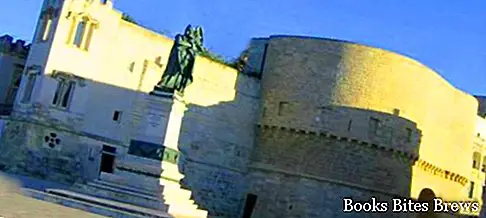What to see in Otranto, itinerary including the main monuments and places of interest, including Castle, Cathedral, Conca Specchiulla and Baia dei Turchi.
Tourist information
Otranto is located in the province of Lecce and is part of the club dedicated to the most beautiful villages in Italy.
In ancient times Otranto was called Hydruntum, from the name of the Hydrus stream, today Idro, which crosses the city before going to flow into the port.
Punta Palascìa belongs to the territory of Otranto, generally called Capo d'Otranto, which corresponds to the easternmost point of the Italian peninsula.
This particular geographical position, projected towards the east, has influenced the history of Otranto in various aspects.
Already in the Messapian era, in the fifth century. B.C. benefited from flourishing trade with Greece, Crete and all the civilizations of the Mediterranean, in the 4th century, with the split of the Roman Empire, it gained importance, but it was especially in the 9th century, in the Byzantine period, that a very flourishing period began for the city, despite various attacks by the Turks.
In 1068 it passed under Norman domination, during which the beautiful cathedral was built which we can still admire today, where in 1095, the twelve thousand Crusaders were blessed who, headed by Prince Boemondo I of Altavilla, left for the Holy Land.
In 1440, the Aragonese conquered Otranto, but failed to stop the dramatic attack by the Turkish army of Muhammad II led by Gedik Ahmed Pasha, which occurred in 1480, during which the city was conquered and eight hundred people were massacred and beheaded because they refused to deny the Christian faith.
They are the martyrs of Otranto whose bones are preserved in the Cathedral and partly in the church of Santa Caterina in Formiello, Naples. The following year Ferdinand of Aragon freed Otranto and strengthened the defensive structure.
Then commercial activities resumed, in particular with the Venetians, who occupied the city for a period (1496-1508).
What see
Porta Alfonsina, which is the main entrance to the ancient city, was built by Alfonso of Aragon after the fierce attack of the Turks in 1481, together with the rebuilding of the city walls, subsequently reinforced by the Spanish viceroys.
Recommended readings- Trani (Puglia): what to see
- Puglia: Sunday day trips
- Manfredonia (Puglia): what to see
- Vieste (Puglia): what to see
- Altamura (Puglia): what to see
In the early nineteenth century, in the Napoleonic era, the Porta Terra was opened along a bastion of the walls.
Following the assault by the Turks in 1480, the Aragonese expanded the remains of a fort from the Byzantine era, creating the Castle, which together with the walls forms a single defensive system.
The current appearance of the fortress, a masterpiece of military architecture, is due to strengthening works carried out during the rule of the Spanish viceroys.
The Cathedral, built from 1080 to 1088, is an elegant fusion of Byzantine, early Christian and Romanesque elements.
On the floor of the church, along the naves, the presbytery and the apse, an exceptional mosaic extends commissioned by Archbishop Jonah and built by the presbyter Pantaleone from 1163 to 1165.
The right apse was enlarged by Ferdinando I to accommodate the remains of the glorious Martyrs of Otranto.
The crypt under the apse is very interesting, characterized by 68 columns and remains of Byzantine frescoes.
Marine locations to the north
– Conca Specchiulla: has a high and rocky coast with small sandy coves, there is a holiday village built near ancient farms.
– Large and Small Alimini Lakes: they are part of a protected oasis and are connected to each other by a canal. They are surrounded by a lot of vegetation with many species of plants, even rare.
– Bay of the Turks: a legend tells that the Turkish warriors landed in this place during the battle of Otranto in the fifteenth century. This bay is part of the protected oasis of the Alimini Lakes.
– St. Stephen's Bay: there are the remains of the Torre di Santo Stefano, it has a predominantly rocky appearance that slopes down to a small beach with lush vegetation. To the south of this bay there is a tourist village with a cave inside the Rada della Caréula.
– San Giorgio beach
– Frassanito beach
Marine resorts south of Otranto
– Baia dell’Orte
– Punta Palascia o Capo d’Otranto, represents the most eastern point of Italy. It is characterized by a coast with cliffs overlooking the sea and its lighthouse which is one of the five lighthouses located in the Mediterranean Sea protected by the European Commission.
It is an interesting tourist destination where there is a tradition of waiting for the dawn of the first day of each year being considered the location of Italy where the sun rises first due to its geographical position.
It also represents the separation point between the Ionian Sea and the Adriatic Sea.
– Torre Sant’Emiliano is a town located south of Punta Palascìa, with a barren landscape with little vegetation. Its name derives from the coastal tower located at 50 meters above sea level. In the area there are also some fortified farms.
– Porto Badisco it is a seaside resort and a very interesting tourist destination for its historical and landscape qualities. Overlooking the Ionian Sea, it is about 35 km from Lecce. Some historians agree that Badisco was Enea's first stop on his trip to Italy after escaping from Troy.
To visit the Grotta dei Cervi, where remarkable paleolithic graffiti are preserved in an environment made up of numerous ravines and very suggestive coves.
Proceeding towards Santa Cesarea-Castro-Leuca, you will come across the Grotta delle Streghe which stands out for having an entrance diagonally crossed by a tongue of rock.




